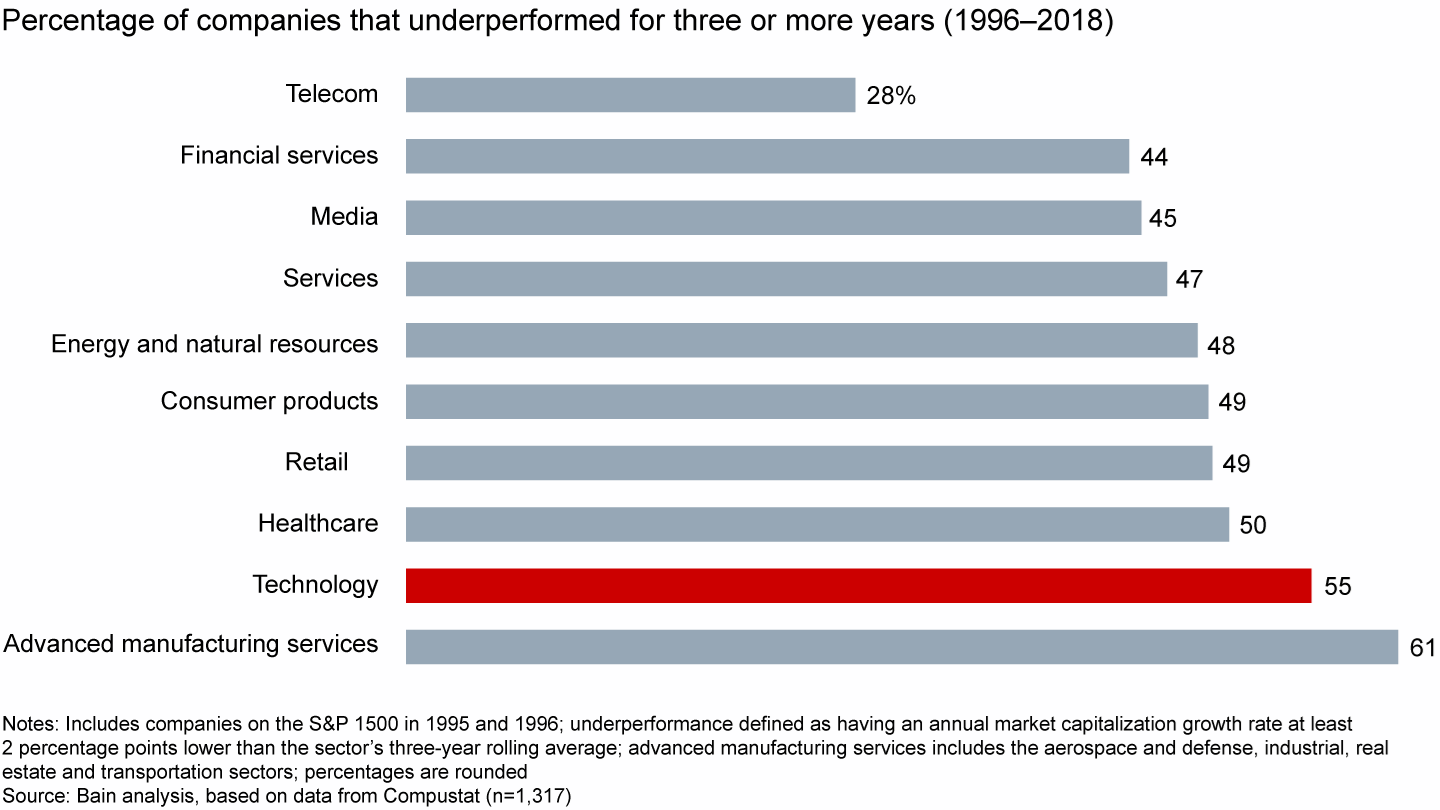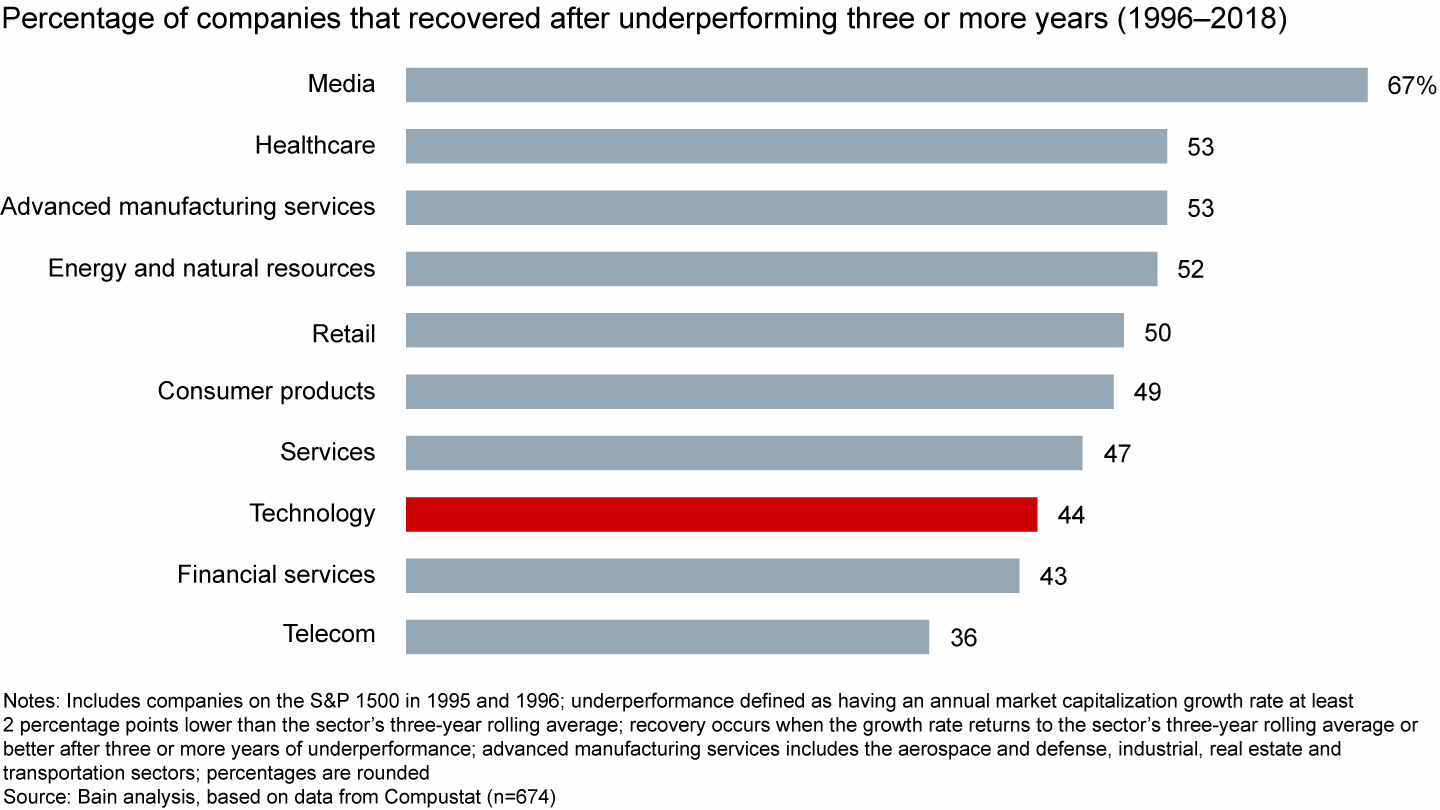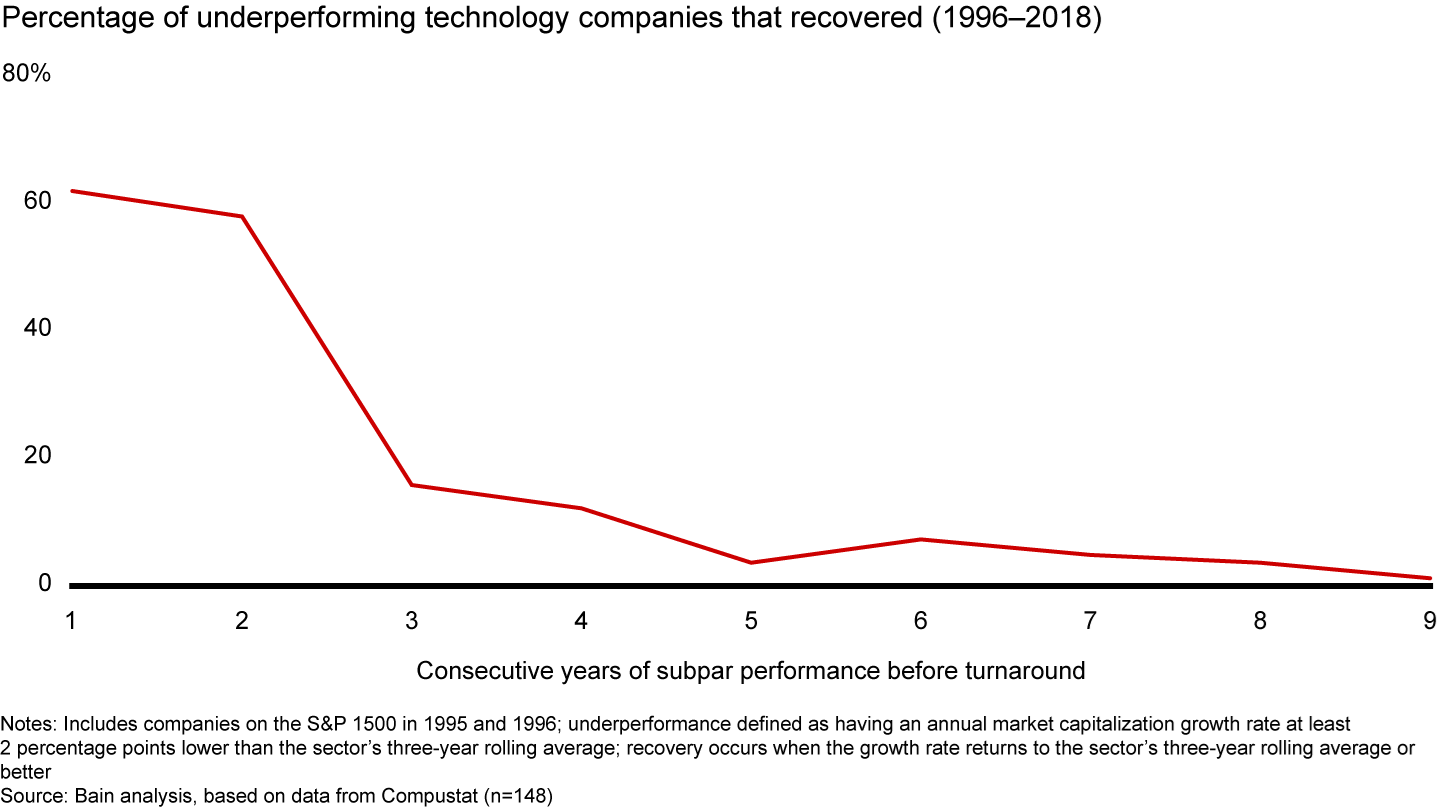Rapport

This article is Chapter 2 of Bain’s global Technology Report 2020. Explore the contents of the report here or download the PDF to read the full report.
For a sobering reminder of the pace of change in technology markets, just look at the turnover at the top (see Figure 1).
The 15 most-valuable technology companies have changed dramatically from 1999 to 2019
In 1999, the list of the 15 highest-valued technology companies worldwide was populated by mainframe legacy companies such as IBM; enterprise resource planning (ERP) darlings such as Oracle; and the winners of the PC/workgroup computing phenomenon: Microsoft, Intel, Cisco, Dell and HP.
A decade later, about half of the list had been replaced. The most notable additions were early winners in search (Google), mobile (Apple, Qualcomm, Samsung) and ERP consolidation (SAP). For the first time, a semiconductor foundry (Taiwan Semiconductor Manufacturing Co.) also made the list.
By 2019, 40% of the top 15 had turned over again. The newcomers illustrate the importance of social media (Facebook) and the growing influence of China (Tencent, Alibaba). But the decade’s most transformative trend was the massive global success of cloud technology. It enabled the growth of other newcomers to the list (Amazon, Netflix, Adobe), and stalwarts from 2009 (Microsoft, Apple, Alphabet) rode the wave to massive valuations 10 years later.
This rate of creative destruction speaks directly to the vibrancy and capacity for innovation of the technology sector. But is this dynamic nature par for the course in most industries?
The answer is no.
Bain research shows that technology companies are 12% more likely to be disrupted than companies in retail and 25% more likely than those in financial services, two other industries that have historically gone through disruptions (see Figure 2). Although the term “disruption” has become a cliché, here we’re specifically referring to companies whose annual market capitalization growth lags their sector’s average by 2 percentage points or more for at least three years in a row. Only advanced manufacturing and services companies have a higher likelihood of being disrupted than technology companies.
Technology companies are easily disrupted


And once a technology company falls behind, it can be difficult to repair. The same Bain research suggests that a technology company that has been disrupted is 12% less likely to return to sector-average market capitalization growth or higher than companies in retail and 17% less likely than those in healthcare, for example (see Figure 3).
Once disrupted, technology companies can be hard to repair


Even more striking, the data shows that once a technology company trails its sector for three years or more, its chances of turning things around are very low, indeed (see Figure 4).
The longer a technology company underperforms, the lower its chances of a turnaround


Why is strong business growth so difficult to maintain in the technology industry? Many industry CEOs attribute it primarily to the speed at which technology transitions occur.
In some industries, such as manufacturing or oil and gas, the cycle times for a paradigm-shifting product to evolve and take hold can take many years, sometimes decades. However, the transition from feature phones to smartphones, for example, was completed in just seven years—from the introduction of the Apple iPhone in 2007 to the sale of Nokia’s handset unit to Microsoft in 2014.
Consumer mobile applications can ramp up with even more dizzying speed. ByteDance was reportedly worth $78 billion just seven years after its 2012 founding. The China-based company rode the runaway successes of TikTok and Musical.ly, an app acquired in 2017 and later merged with TikTok. These apps helped usher in an era of videostreaming and social media built on simple tools that allow users to post short, creative videos and riff off of each other’s creations. TikTok is now a global phenomenon with hundreds of millions of daily users, although it’s currently confronted by a controversy over how it handles user data and is under pressure from the Trump administration to become part of a US-based company.
The pace of these transitions continues to accelerate. After launching in 2004, it took Facebook less than four years to reach 50 million users, according to news articles. By 2016, it took Instagram Stories less than two months to get to 50 million users, BuzzFeed News and other media outlets reported.
This also speaks to the “winner-takes-most” effect in the technology industry. Due to abundant cloud-computing infrastructure and mobile connectivity worldwide, a technology platform can reach a massive audience at unprecedented rates. And, of course, increasing scale digitally is nearly frictionless. It doesn’t require the time or costs involved in producing or distributing physical products. Ultimately, scale accrues so quickly to the winners that once a transition is missed, it’s difficult for other companies to get in the game.
As all technology executives know, technology talent is remarkably mobile and often compensated with company stock. When a technology firm falls behind in its sector, employees often dust off their résumés and begin scouting new jobs at the next fast-rising company.
Finally, most technology companies find they must rely on mergers and acquisitions to reposition and extend their businesses. But many lose several years mired in a common series of pitfalls before they hone their M&A strategy and skills. These missteps often include assigning core-business veterans to new market domains where they lack necessary expertise; hiring token outsiders who struggle to lead veteran teams; and making tiny acquisitions and overintegrating them to the point that the benefits of the deal are dissipated. The time lost navigating these mistakes often closes the company’s window for recovering.
Technology CEOs understand these challenges well, but that doesn’t make them any less daunting. So, how do leading technology companies create value and—just as important—maintain it? The keys are getting the most out of their core businesses and being willing to evolve, even when it’s painful in the short term.